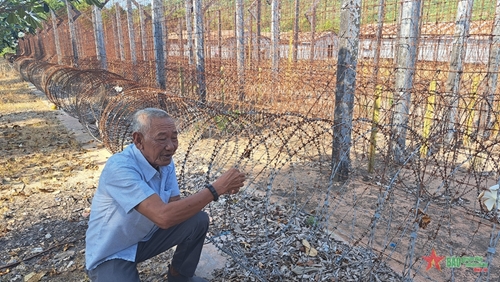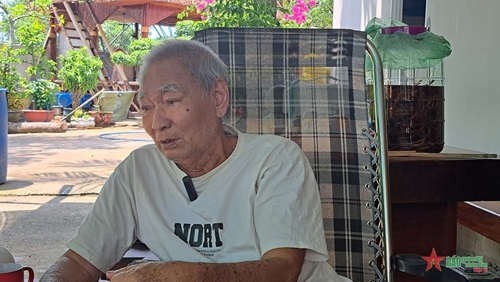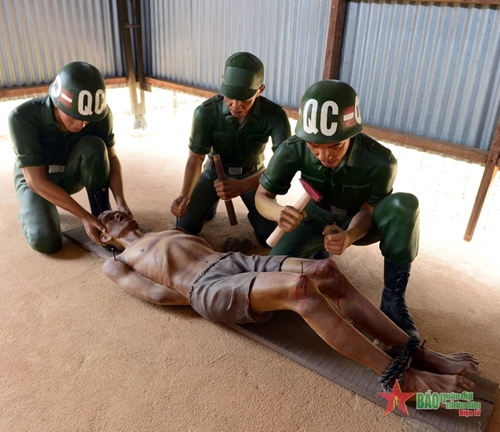These days, coming back to Phu Quoc Prison - known as “Hell on Earth,” former prisoners of war (POW) recalled dreadful and brutal tortures by jailers.
    |
 |
|
Mr. Phu Xi Khieu, former Phu Quoc POW, revisits Phu Quoc Prison. |
Going along a small path leading to the gate of Phu Quoc Communist POWs’ Prison, many people got the shivers after witnessing a dozen layers of sharp barbed-wire fences and models of prisoner guards holding guns. The iron door creaked when we opened it slowly. The screeching noise made us partly feel the dark atmosphere of the ruthless prison during the colonial and imperialistic periods.
Among groups of tourists nationwide visiting Phu Quoc Prison, we luckily met and talked with Mr. Phu Xi Khieu, a former Phu Quoc prisoner in the 1971-1973 period.
Looking back on his memories, Mr. Khieu shared that returning to Phu Quoc after 50 years, he was delighted at the rapid development of Phu Quoc city. However, he could not hold back his tears as he remembered his fallen comrades. They together fought bravely till their last breath.
    |
 |
|
Mr. Nguyen Van My (also called Nguyen Ngoc Toan or Ba Toan) led a group of prisoners in subdivision B2 to escape. |
Phu Quoc Prison is located in An Thoi townlet, Phu Quoc city, Kien Giang province. The book “Phu Quoc Prison historical relic” released by the Labor Publishing House (1941-1944) revealed that the French colonists built three prisons on Phu Quoc Island to detain nearly 1,000 Vietnamese revolutionaries and then dissolved.
In June 1953, the French re-built Cang Cay Dua POW Prison Camp (also known as Coconut Tree Prison Camp). It was considered the largest prison in Indochina at that time, with an area of around 40 hectares, capturing 14,000 Vietnamese soldiers from the North, Central, and South.
In 1954, the Geneva Accords was signed, France agreed to return Phu Quoc prisoners, and the prison was closed down. At the end of 1955, the Republic of Vietnam (South Vietnam) and the U.S. reused Phu Quoc Prison as the national prison to confine nearly 1,000 political prisoners. The South Vietnam government renamed it Coconut Tree Training Camp, also called Coconut Tree Prison. The prison closed in March 1957.
In 1967, the prison was reconstructed with the name “Vietnam-Phu Quoc Communist POW Prison Camp.” Covering an area of 400 hectares, the camp was the largest prison in the South. It comprised 12 main sections holding more than 40,000 revolutionaries in the 1967-1973 period.
Recalling the prison escapes, Mr. Nguyen Van My (also called Nguyen Ngoc Toan or Ba Toan), a former POW in the prison camp, shared that he led a group of prisoners in subdivision B2 to escape the prison on May 22, 1968. Initially, the group had three people. Subsequently, a group of three and a group of five followed them. They took advantage of heavily rainy nights to cut and get through the fence to escape.
Compared to the Coconut Tree Prison in wartime, the Phu Quoc Prison historical relic today is smaller. According to Mr. Ho Dac Thuan, Director of the Center for Culture, Sports, and Radio Broadcasting of Phu Quoc city, in order to preserve and uphold the relic’s values, over the past years, the province has renovated several projects, including jails, canteens, kitchens, two houses of prison guards while restoring the underground trench to escape from the prison, a part of barbed wire fence, tiger cages, the monument at the prisons’ cemetery, among others. Therefore, every year, the relic receives 10,000 tourists at home and abroad.
    |
 |
|
The enemies use 45 different ways to brutally torture Vietnamese revolutionaries. |
Fifty years have passed, today and future generations will never forget the merits of their predecessors, who sacrificed their blood and flesh, youth and lives for peace. Therefore, those who returned from the “Hell on Earth” will continue devoting themselves to the renewal cause of the country. For Phu Quoc Prison, the place not only contributes to the diversification of the province’s tourism products but it is also seen as a “red address” to educate young people of the tradition “When drinking water, remember its source.”
Translated by Quynh Oanh